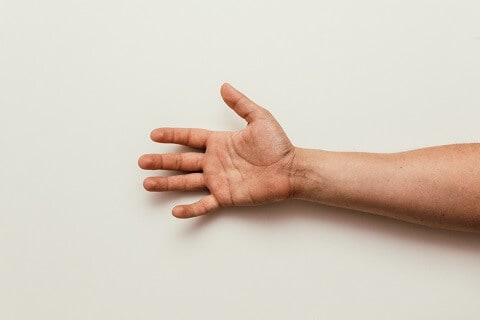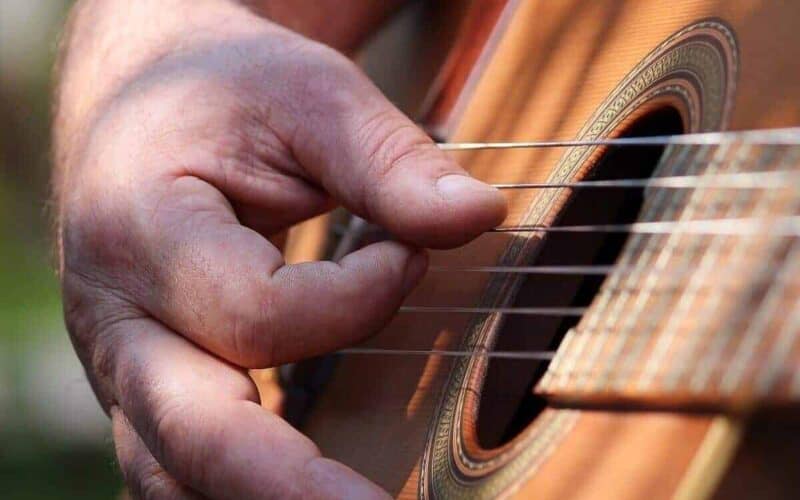What is the most common thing that beginners complain about? ‘Their Hands and fingers!’ More or less everyone has the same complaint that they are playing guitar with small hands or chubby fingers.
Sure, having small hands or fat fingers can make some guitar moves more difficult than for those with larger mitts. But that doesn’t mean you can’t learn how to play guitar if you have small hands.
Many legendary guitarists have conquered the fretboard despite their tiny hands. Angus Young, Nancy Wilson, John Petrucci, and Johnny Hiland are all well-known guitarists, and they all have hands on the smaller side.
So if you’re wondering how to play with small hands, know that it is possible to overcome any size disadvantage. All it takes is a bit of effort and the correct playing techniques.
Now let’s look at some tips on playing guitar with short fingers or small hands so you can rock out regardless of your hand size.
Tips for Playing Guitar with Short Fingers and Small Hands
Here we are sharing some practical tips best for those guitar players who are struggling to play the guitar due to their physical limitations. Check out all these tips to know your lackings and what to do to improve your guitar playing.
1. Choose the Right Guitar
First thing’s first. You need to get the perfect-sized guitar for yourself. If your guitar is not appropriate according to your anatomy you won’t be able to hold it properly. When buying a guitar keep in mind that while holding the guitar, it should maintain the perfect height.

The best guitar body shapes for small hands are the ones that are smaller in size overall. These include parlor guitars, 3/4 size guitars, and grand concert guitars. If you’re looking for an electric guitar, a “Stratocaster” style guitar will also be a good option since it has a slimmer body.
However, be noted that to play efficiently, using a compact size or short-scale guitar for players with smaller hands is not obligatory. You can play regular size guitar after proper training and enough practice.
Here are some other things you should keep in mind when choosing a guitar if you have small hands or short fingers are as follows:
Guitar Neck Width
The best way to play guitar with small hands is by opting for a guitar with a narrower width neck. A narrow or slimmer neck will make it easier for you to grip the strings and press them down.
The standard neck width on acoustic guitars is 1.73 inches (44mm) while the standard electric guitar neck is below 1.7 inches, and the classical guitar neck is 2 inches.
C-shaped necks are the best for people with small hands as they offer a better grip. On the other hand, U-shaped or D-Shaped necks are wider and not recommended for people with smaller hands.
Fretboard Radius
The fingerboard radius is the measurement of how curved the fretboard is. It is the distance from the center of the board to its outer edge. A flatter or smaller radius is better for those with small hands as it makes fretting chords easier.
Guitar String Gauge
The thickness of the guitar strings also makes a difference. If the string gauge is too thick, it will be hard to press them down. Conversely, thinner or light gauge strings are easier to press, but they might break more easily.
The ideal acoustic guitar string gauge for people with small hands is between .012 and .053 whereas the best string gauge is between .009 and .042 for electric guitarists.
You can use D’Addario EJ16-3D Phosphor Bronze (.012 – .053) light gauge strings or use .010- .047 extra light/lighter gauge strings like D’Addario XT Phosphor Bronze for acoustic guitars.
For electric guitars, choose from D’Addario Nickel Wound Super Light Strings (Gauges: .009- .042) or even drop down to .008- .038 extra light strings like Ernie Ball Extra Slinky.
String Spacing
The distance between the strings also plays an important role when choosing a guitar. Go for a guitar with narrower string spacing, so your fingers don’t have to stretch too much when fretting chords. Conversely, too much narrow spacing could make it difficult to fret notes cleanly.
2. Set Up Your Guitar Properly
After choosing the perfect guitar, you need to set it up properly so that playing becomes more comfortable for you. There are several adjustments that need to be made when trying to set up a guitar for small hands, such as adjusting the string action, the string spacing, the neck relief or setting up the intonation, etc.
For a beginner, understanding the exact setup requirement and doing it at home is a somewhat difficult task and you can damage your guitar if you don’t have the technical knowledge. Therefore, we recommend that you take your guitar to the nearest local music store and have it set up by a professional.
3. Hold Your Guitar Correctly
Most beginners start off by holding the guitar incorrectly. When your guitar isn’t positioned right it will cause you great trouble in terms of producing the proper music.
If you are right-handed, rest your guitar comfortably on your right lap at first. The back of your guitar should be on your stomach, and the neck should be tilted slightly upwards relative to the body of the guitar.
Also, keep in mind that the guitar should not be parallel to your chest. Hold it in an angling position so that the left side can be slightly moved with the left hand and the right side moved backward with your plucking hand.
So, the more correct postures you maintain the more comfortable you’ll be while playing guitar regardless of your smaller hand.
4. Stretch Your Fingers

Another essential tip for a guitarist with small hands is to warm up your fingers before playing. Just like athletes need to stretch before exercise, it’s necessary to limber up your fingers before playing guitar.
In the beginning, you will feel as if you’re producing muffling and muting sounds on and on. Maybe you’ll find the strings way too far to stretch and curse your little hands!
By regularly stretching the fingers, your muscles will get used to and eventually will develop dexterity in your guitar skills. It will help prevent pain in your hands and make it easier to reach the chords and notes you want to play.
To warm up your fingers, try doing some simple finger exercises as shown in the following video:
5. Change Your Tuning
If you’re struggling to make proper chord shapes with your short fingers, you might consider changing your guitar tuning.
One of the most popular alternate tunings for guitar is drop D tuning. To do this, simply lower the pitch of your low E string by one whole step (two frets). It gives you a deeper, richer sound and can make some chords much easier to play.
For example, a standard E minor chord shape becomes much simpler in drop D tuning. You can place your first finger on the second fret of the low E string and strum away. No need to worry about that pesky barre chords.
Check this guitar lesson on How to tune your guitar to Drop D Tuning:
If you want to stay in standard tuning, there are still some things you can do to make chords easier to play. For instance, you can try a partial barre chord shape. It is where you only lay your finger across a few strings instead of all six guitar strings.
6. Use a Capo
For the beginners out there, I would suggest using a capo on your guitar. Now a capo is a small device that is used to clamp on the neck of the guitar so that the length of the strings shortens.
It means that the frets are closer together and easier to press down. If you can’t play open chords by the nut and want to play similar sounding chords elsewhere on the fretboard, then a capo will help you immensely.
You can also use a capo to change the key of a song without learning all the chords. So if a song is in the key of G and has some tricky chords, you can put your capo on the second fret, and now it will be in the key of A. All you have to do is transpose the chords from G to A, which is a lot easier.
Don’t be afraid to experiment with capos and find the best position for your hands. Try using a capo on the 4th or 5th fret. You’ll notice how easier it will get as you don’t have to stretch your hands that much. Small hands won’t be a problem anymore then!
7. Thumb Position and Finger Contact with the Fretboard

I know a lot of people complaining about their ‘fat fingers’ just because they use their finger pads, not their fingertips. When you use your finger pads instead of the tip you will create a muffling sound unintentionally. So to avoid this you need to follow some steps.
First of all, take your thumb off the fretting hand back of the guitar neck and rest it in the middle. The top part of your palm must be facing the fretboard of the guitar. Then slightly curl your fingers at the knuckles and place them above the strings.
But some guitarists use their thumbs to fret notes, and that would be quite difficult for someone with smaller hands. So don’t try to master that skill at the very beginning stage of your guitar learning.
Usually, beginners play comfortably when fretting just a single string. But when they need to hold chords it becomes a lot more difficult for them. They mix up tunes as the adjacent strings also ring up under improperly positioned hands. Once your fingers start stretching, you’ll automatically build up a habit of tuning up in the right way.
8. Practice Chords with Smaller Fingers
Once you get used to using your pinky finger more often, you can start practicing some bigger chords that require that finger. For example, an A major chord can be played by barring the second fret with your index finger, placing your ring finger on the fourth fret of the D string, and putting your pinky on the fifth fret of the G string.
Or you can try a Dsus4 chord by barring the second fret with your index finger and placing your ring finger and pinky on the fourth fret of the G and B strings, respectively.
These are just a few examples of how you can use your pinky to make bigger chords that would otherwise be tough to play with small hands.
9. Take advantage of higher frets
One big advantage small-handed guitarists have is that they can more easily reach higher frets. Although beginners are often taught to start practicing single notes around the 3rd or 5th fret, there’s no reason you can’t jump ahead and get used to the upper region of the fret.
Since players with larger hands may feel cramped when they attempt to play higher up the fretboard, small-handed guitarists actually have an advantage in this area. So make use of it and explore the upper region beyond the twelfth fret. You may be surprised by how comfortable and pleasant it is to get familiar with the patterns and get used to them.
10. Consider A Short Scale Or 3/4 Size Guitar
One of the best things you can do if you have small hands is to consider a short scale or 3/4-size guitar. These guitars are specifically designed for people with smaller hands, and they can make a world of difference when it comes to playing with comfort and ease.
The main advantage of these guitars is that they have shorter necks, which makes it much easier to access different frets and play chords. They are also typically very lightweight and easy to carry around, so you won’t have any issues taking them with you on the go.
If you’re not sure what guitar size is right for you, it’s always a good idea to try some different models in your local music store to see what feels comfortable. Also, check out our article on “Best Acoustic Guitars For Small Hands” to get more ideas about which models to look for.
11. Consider playing an electric guitar
If you are playing acoustic guitar and find it hard to hold and fret, we would recommend playing an electric guitar. An electric guitar’s body is smaller and thinner as compared to an acoustic guitar which makes it easy to hold and play.
In addition, the electric guitar neck is thinner, the strings are much closer to the fretboard and the string gauges on an electric guitar are also lighter than an acoustic guitar. This means that less finger pressure is required to hold down the strings which makes it easier for a guitarist to play with small hands or short fingers.
12. Practice, Practice, and Practice
Practice is the key to overcoming any physical or mental limitations related to learning a new skill. The more you practice; it will become easier to adjust to your weaknesses. Even you may find new techniques to succeed over your obstacles come from smaller hands.
Though at first, it seems very hard to overcome physical limitations but don’t give up or leave your practice. There are many examples in front of us that people who have overcome all sorts of physical limitations and become excellent guitarists after a certain period.
Nowadays you will find on various social media that some 6 or 7 yr old kids play a regular size guitar well enough then most of the elder guitar players. So Practice is the actual real thing that matters.
Remember, it takes time and patience to master everything in life. So stay positive, focus on your progress and enjoy the journey. Who knows, you might be the next Jimi Hendrix.
Conclusion
Playing guitar with short hands or chubby fingers it’s not a problem you see! Just choose the right instrument for you and keep practicing with patience. Your physic won’t be a problem anymore. Just stop worrying and start practicing guitar.
About the Author
Fabian, a Brazilian guitarist now based in Dublin, Ireland, has passionately played the electric guitar since 2003. As a luthier and product specialist, he boasts nearly two decades of collaboration with top musical instrument brands. Fabian is a sought-after expert, sharing his extensive knowledge with fellow guitar enthusiasts.





I don’t have the biggest hands but I have managed to improvise and find ways because of immense passion to play the songs that I hold dear to my heart. if you have the want and desire you will find a way!!!!!!
My hands are small AND chubby but I manage. My hands are so small I can barely wrap my thumb around the top of the fretboard. It was a process I had to figure out on my own but it can be done. I use a rolling technique for a lot of chords. Not sweeping but not fretting chords with proper technique either.